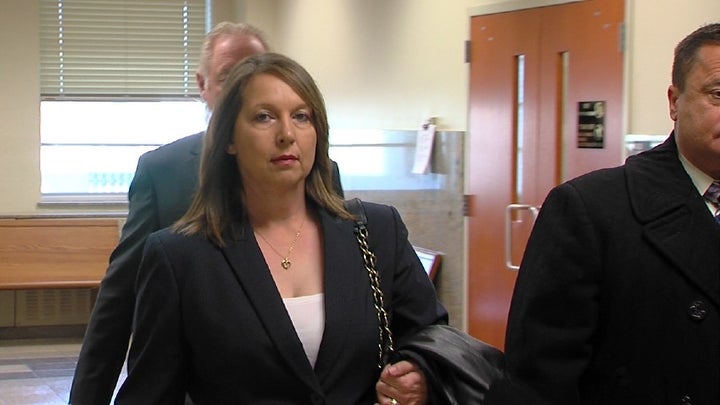
Back in September, Terrence Crutcher, an unarmed Black man, was walking to his car with his hands up when he was shot by Tulsa police officer Betty Shelby. This incident was caught on video by both a police dash cam and an aerial video from a police helicopter wherein an officer looking on the scene profiles Crutcher and calls him a ‘bad dude.’
Recently on “60 Minutes,” Shelby said Crutcher “caused his own death” by “failing to comply” to her orders. She insisted that race had nothing to do with her shooting and killing an unarmed man. This was bad enough, but they were all things I’ve heard before. What happened next convinced me that I was in the White supremacy Matrix.
With tears in her eyes, this woman had the audacity to say that she feels like a “lynch mob is after her.” Thereafter, her husband, also a police officer, said that there were two victims that night in September: Crutcher and Shelby.
Somehow this woman has found a way to talk herself into thinking she is a victim. She sat on national television and cried the Whitest of tears while expressing zero remorse for killing a man whom she thought had a gun, but, in fact, had one neither on his person nor in his car.
When she talked about a lynch mob coming to get her, I had cognitive dissonance. I could not believe I was in Oklahoma listening to a White woman talk about how she was afraid of a lynch mob.
How could she, a White woman, say that with a straight face in a city where White folks were responsible for the destruction of Black Wall Street– the worst mass killing of Black people in American history. An incident that began on the night of May 31, 1921 and lasted only 14 hours resulted in 35 city blocks burned, 800 people injured and more than 300 people killed. The mass murder finally ended when Adjutant General Charles Barrett of the Oklahoma National Guard arrived with 109 soldiers and declared martial law—but Darth Susan was sitting on my TV talking about how she was afraid of a lynch mob.
Then I thought about Laura and LD Nelson. On the night of May 2, 1911, a four-man posse arrived at the Nelson home to search for stolen cows as Laura, her husband Austin, their 14-year-old son L.D., and 2-year-old daughter Carrie were sleeping in bed. Startled by the men who burst into their home, L.D. grabbed a rifle off the wall to defend his family, but as Laura tried to wrestle the firearm away, it discharged and fatally wounded Okfuskee Deputy Sheriff George Loney. On the morning of May 25, a lynch mob of 40 men arrived at the county jail and carried away L.D. and Laura. She was sexually assaulted, and then along with her son, lynched. As their Black bodies swung in the winds that came sweeping down the plains, the lynch mob posed for local photographer George Henry Farnum who captured an image that was later used on postcards. A district judge convened a grand jury, but no charges were filed because witnesses were unwilling to identity the 40 murderers—but no.
She was talking about neither Black Wall Street nor the Lynching of Laura and LD Nelson. She did not see that her killing Crutcher participated in the legacy of white violence against black bodies in Oklahoma. She was concerned about her feelings.
Crutcher reminded me of my uncle: a southern Black man who loved God, struggled with drug addiction and had a generous heart. She did not see him. She, like the police officer who was in the helicopter-circling overhead, saw a ‘bad dude.’ Or perhaps it was a ‘bad guy’—like the kind she told her grand son to chase as he rode in a toy police car later in the interview, reminding me of the way that anti-Blackness and stereotypes are passed down generation to generation.
I am constantly amazed by how police officers find a way to reason with and subdue white offenders without killing them, but Black men and women in far less confrontational encounters consistently end up dead.
Recently, NPR released a story on their podcast Embedded about a police shooting that could have happened—but did not. That perpetrator was threatening, running toward a police officer with his hands in his pocket, but the police used restraint. Of course, the suspect was White.
Terrence Crutcher had his hands up, was walking away from the officers, and, as his sister informed us, was most likely putting his hands on the car as he had been taught to do by his father when interacting with the police. It is sadly ironic that what his father taught him to do as a means to try to teach his son how to survive police encounters is what probably got him killed.
No. He was murdered.
What amazes me is not that it happens, but that police officers continue to insist that race has nothing to do with it. The same way that a glitch in the game had nothing to do with why Bo Jackson kept breaking through tackles every time you play with him in Tecmo Super Bowl.
Betty Shelby is the worst type of Darth Susan. What’s worse, she will most likely be found innocent because she will have a jury of her peers.
This originally appeared on VerySmartBrothas.com.
